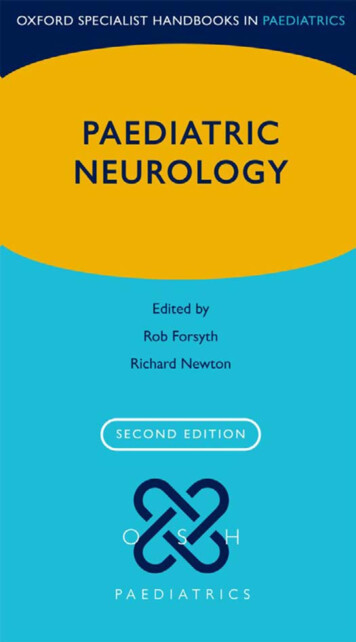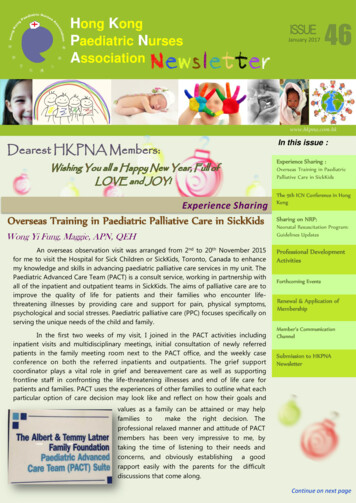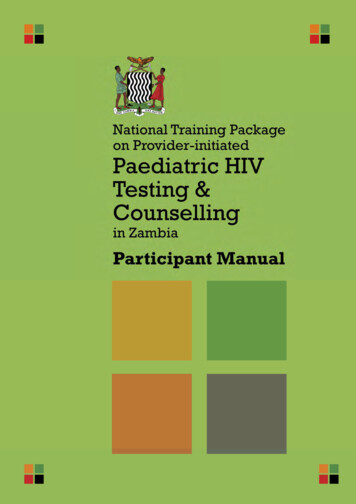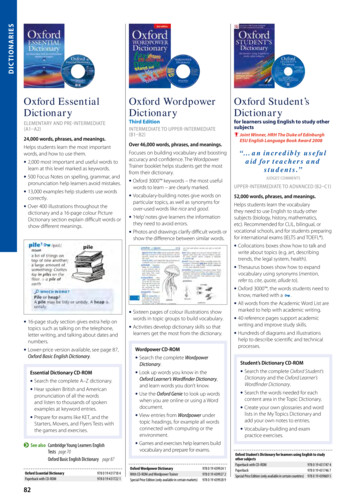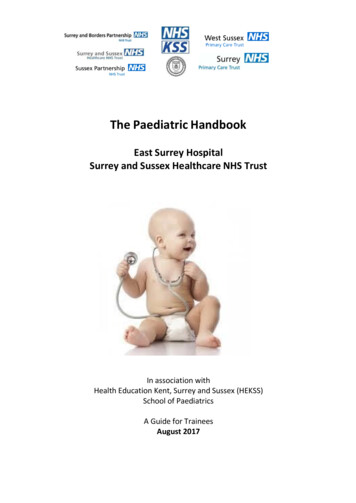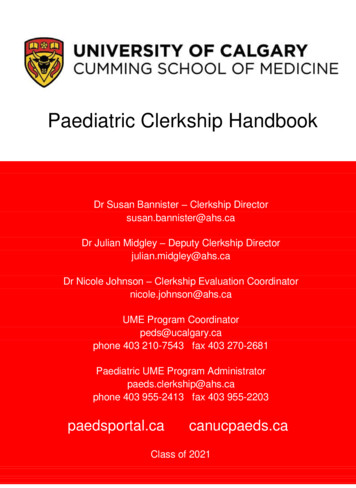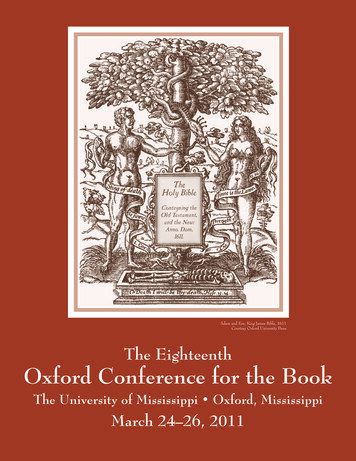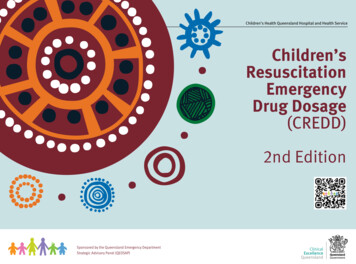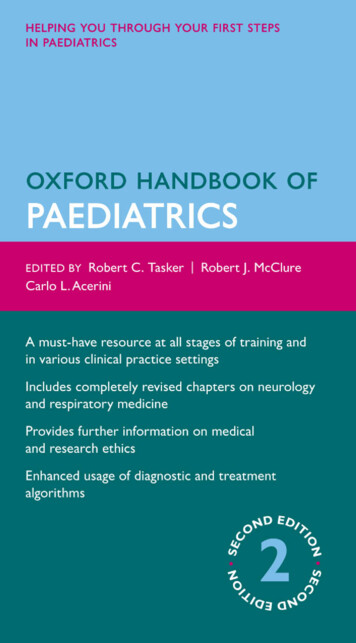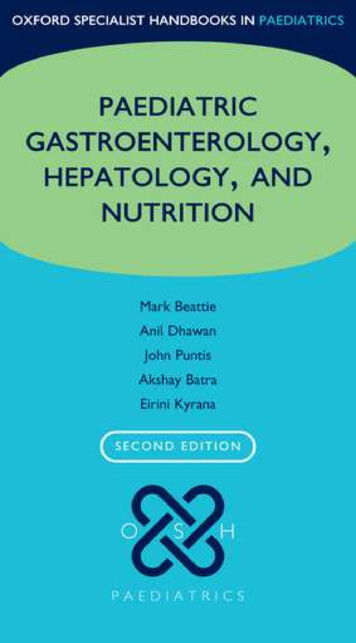
Transcription
htttuesqer
phttqukreestphttqukreestphttestuqOxford Medical Publications tology, testuqre.mhtttuesqer
phttiiphttOxfordt Specialist Handbooks published and eforthcomingtssHandbookseGeneralOxford SpecialistOxford SpecialistuuqqHandbooksin Neurologykre A ResuscitationkreRoom GuideEpilepsyoAddiction Medicineand Other MovementboDisorders,DiseasetParkinson’sDay Case Surgery2exetParkinson’s Disease and Other MovementMedicine, 2ee/ StrokeDisorders 2eOxford Specialist HandbooksPerioperative Medicine, 2e /t.mt.m///in OncologyPharmaceutical Medicine::ps 2epsPostoperative Complications,Practical Management of ComplexRenal TransplantationCancer PainhtthttRetrieval MedicinequkreOxford Specialist Handbooksin AnaesthesiaAnaesthesia for Medical and SurgicalEmergenciesCardiac AnaesthesiaNeuroanaesthesiaObstetric AnaesthesiaOphthalmic AnaesthesiaPaediatric AnaesthesiaRegional Anaesthesia, Stimulation andUltrasound TechniquesThoracic AnaesthesiaestOxford Specialist Handbooksin PaediatricsPaediatric DermatologyPaediatric Endocrinology and DiabetesPaediatric Gastroenterology, Hepatology,and NutritionPaediatric Haematology and OncologyPaediatric Intensive CarePaediatric Nephrology, 2ePaediatric Neurology, 2ePaediatric Palliative Medicine, 2ePaediatric RadiologyPaediatric Respiratory MedicinePaediatric Rheumatology/ps:httestuqrekoobtex/te/t.mOxford Specialist Handbooksin CardiologyAdult Congenital Heart DiseaseCardiac Catheterization and CoronaryInterventionCardiac Electrophysiology and CatheterAblationCardiovascular Computed TomographyCardiovascular Magnetic ResonanceEchocardiography, 2eFetal CardiologyHeart Failure, 2eHypertensionInherited Cardiac DiseaseNuclear CardiologyPacemakers and ICDsPulmonary HypertensionValvular Heart DiseasehttOxford Specialist Handbooksin Pain MedicineSpinal Interventions in Pain ManagementestuqkrekhttOxford Specialist Handbooksin Critical CareAdvanced Respiratory Critical CareCardiothoracic Critical CareestuqreOxford Specialist Handbooksin End of Life CareEnd of Life Care in CardiologyEnd of Life Care in DementiaEnd of Life Care in NephrologyEnd of Life Care in Respiratory DiseaseEnd of Life in the Intensive Care Unit//t:sphtt.m//t:spOxford Specialist Handbooksin RadiologyInterventional RadiologyMusculoskeletal ImagingPulmonary ImagingThoracic Imaging.mhttestOxford Specialist Handbooksin SurgeryCardiothoracic Surgery, 2eColorectal SurgeryGastric and Oesophageal SurgeryHand SurgeryHepatopancreatobiliary SurgeryNeurosurgeryOperative Surgery, 2eOral and Maxillofacial Surgery, 2eOtolaryngology and Head and Neck SurgeryPaediatric SurgeryPlastic and Reconstructive SurgerySurgical OncologyUrological SurgeryVascular Surgery, 2eureqkoobextt/eOxford Specialist Handbooksin Infectious DiseaseInfectious Disease EpidemiologyManual of Childhood Infections 4eestuqreestuqkreooOxford Specialist Handbooksin PsychiatryAddiction Medicine, 2eChild and Adolescent PsychiatryForensic PsychiatryMedical PsychotherapyOld Age r
qukreestqukreestphtthttestuqOxford Specialistkreooxtb nhttpPaediatricGastroenterology,estuqkre andHepatology,ooxtbete/mNutrition.tt.m////::ssst BeattieeMarkuqkre Consultant PaediatrickstJohn WL Puntisin PaediatricsteConsultantGastroenterology and Nutrition,uqre The General Infirmary at Leeds,Leeds, UK//t:sp.mkreooConsultant in Paediatric Hepatologyand Professor of PaediatricHepatology, King’s College London,London, UKxtbee/tm//t.ps:httpeAnil DhawanquGastroenterologist, UniversityHospital Southampton NHSFoundation Trust, and HonoraryProfessor of PaediatricGastroenterology and Nutrition,University of Southampton,Southampton, UKAkshay icbo inLeedsChildren’sxtHepatology,ete/ Hospital, Leeds, UKt.m//:pshtt1tuesqer.mhttConsultant PaediatricGastroenterologist, UniversityHospital SouthamptonNHS Foundation Trust,Southampton, UKhttestuqre.m
phttivphttestuqkre 1estuqkreooGreat Clarendon Street, Oxford, OX2 6DP,tbxeUnited Kingdomte/ of the University of Oxford.Oxford University Press is a departmentm.tt.m//It furthers the University’sobjective of excellence in research, scholarship,//::and education by publishingps worldwide. Oxford is a registered trade mark of ttpsOxford UniversityhttPress in the UK and in certain other countriesh Oxford University Press 2018The moral rights of the authors have been assertedst Edition published in 2009eFirstuSecond Edition published in 2018qkre Impression: 1estuqrekoobtexAll rights reserved. No part of this publication may be reproduced, stored ina retrieval system, or transmitted, in any form or by any means, without theprior permission in writing of Oxford University Press, or as expressly permittedby law, by licence or under terms agreed with the appropriate reprographicsrights organization. Enquiries concerning reproduction outside the scope of theabove should be sent to the Rights Department, Oxford University Press, at theaddress above/t/ps:htte/t.mhttYou must not circulate this work in any other formand you must impose this same condition on any acquirerst in the United States of America by Oxford UniversityePressstePublishedu198 Madison Avenue, New York, NY 10016, United StatesqofuAmericaqkre British Library Cataloguing in Publication Data okreoData availablextbeLibrary of Congress Control Number:2018940620te/ISBN 978– 0– 19– 875992– 8 .mt:// byPrinted and bound in sChinapC&C Offset PrintingCo.,tht Ltd.k.m//t:sp.mhttOxford University Press makes no representation, express or implied, that thedrug dosages in this book are correct. Readers must therefore always checkthe product information and clinical procedures with the most up- to- datepublished product information and data sheets provided by the manufacturersand the most recent codes of conduct and safety regulations. The authors andthe publishers do not accept responsibility or legal liability for any errors in thetext or for the misuse or misapplication of material in this work. Except whereotherwise stated, drug dosages and recommendations are for the non- pregnantadult who is not breast- feedingestuqre//t:spestureqkoobextt/Links to third party websites are providedOxford in good faith andme any byresponsibility.disclaimsfor information only. Oxfordfor the materialstt.m////::contained in any thirdspartywebsite referenced in this work.ppshtthttestuqretuesqer
phttqukreestphttForeword to the equrfirst edition tbookex/tmeThere is a romantic notion that paediatric gastroenterology in the UK beganin a smoke- filled room in a pub somewhere in the 1970s. In fact, the truthis more prosaic. It did begin in the early 1970s, but in a seminar room in theMedical School in Birmingham, when a small group of leading exponentsdecided to form the British Paediatric Gastroenterology Group. Then, therewere only a handful of tertiary specialists in paediatric gastroenterology,and only one in hepatology; nutrition was only incorporated 20 years later.Since then, of course, paediatric hepatology has come of age, its growthhelped enormously by progress in transplantation science and immunology. In Victorian households, feeding the children was usually left to themost junior and inexperienced housemaid. Perhaps as a consequence, theobservation that malnutrition is bad for the child has only been formallyrecognized somewhat belatedly in developed economies. Indeed, we nowrecognize that in certain disorders, nutritional therapy is a key componentof the primary treatment.The editors and their contributors are to be congratulated for havingcondensed a large subject into a small format and for having left nothing ofimportance out; the bullet point style is particularly suited to this kind ofpublication. It is particularly pleasing to see clinical nutrition so comprehensively dealt with; there is much here that makes this publication relevant toall paediatric specialties. One disadvantage of clinical nutrition having beenchampioned by gastroenterologists has been the mistaken belief that nutrition is relevant only to those patients with gastrointestinal disease.This book provides a valuable concentrate of all the clinically relevant knowledge that we have acquired in this burgeoning field over thelast 30 years. Often in paediatrics, the evidence based on which to makedecisions is lacking and this specialty is no exception. The reader is therefore fortunate in having access to a pragmatic blend of evidence and clinical wisdom distilled and organized by three highly experienced specialists.The book provides a quick reference for the specialist, but is likely to beparticularly useful for the non- specialist and for the trainee in paediatrics.Whatever changes may occur in the role of the doctor, they will still have tomake diagnoses and initiate treatment. Moreover, all members of the largeclinical team now required to look after many of these complex patients willfind it helpful to have this book close to hand.Professor Ian BoothDean, Leonard Parsons Professor of Paediatricsand Child Health, The Medical School, Birmingham, m//t:sphtthtqukrekvesthtttuesqer
phttviphttviqukreesttForeword to the equesroksecond editionotbex/tmeMedical textbooks are written for several reasons. Occasionally, theyhave appeared to be a vanity project; at other times to self-proclaim theexcellence of an individual clinical department. Often in the past they havehad the important function of establishing a new subspecialty and definingwhat it is and what it does. In paediatric gastroenterology, this was animportant function of the textbooks edited by Charlotte Anderson andJohn Harries in the 1960s and 1970s. In contrast, many paediatricians andgeneral practitioners in the United Kingdom struggled with the conceptof community paediatrics because a textbook defining the specialty andwhat its practitioners were required to know was missing. So, the role oftextbooks goes beyond helping to inform the management of a specificclinical problem.This handbook has been written to impart clinical information andguidance in a specialty already firmly embedded in the practice of paediatrics. But rather than use the printed word to arrive at diagnosis andtreatment, why not rely on the plethora of invited reviews and evidencebased guidelines available electronically? Photographers know that the bestcamera is the one that you have with you; the same applies to sources ofclinical guidance. That is why the Oxford Handbook continues to be a valuable addition to patient management. It remains a distillation of information and knowledge from the impressive array of contributors assembledby the editors and one that can be accessed close to the patient. For ahandbook, it is remarkably comprehensive and detailed and will providevaluable guidance to all members of the multidisciplinary team, particularlyon those frequent occasions in paediatric practice when a handy evidencebased review is not available.Professor Ian BoothEmeritus Professor of Paediatrics and Child HealthUniversity of Birmingham, tuqkrek.m//t:sphtthtttuesqer
phttqukreestphttPreface to the equrfirst edition tbookex/tmePaediatric gastroenterology, hepatology, and nutrition encompass a widerange of paediatric practice with conditions being managed in a wide varietyof settings, dependent upon their complexity. This includes primary care,secondary services, and specialist paediatric practice. Conditions such asabdominal pain and constipation can be assessed in any of these settings.Conditions such as inflammatory bowel disease, intestinal failure, and liverfailure require specialist assessment but still shared care within the widerhealthcare environment. Nutritional problems are seen by us all in everydaypractice with nutritional support being an integral part of the managementof any chronic disease.This book is intended as a practical reference for practitioners who commonly see such conditions both in training and in clinical practice. The idea isthat they can dip in for information on practical management but also background information on specific conditions. The chapters reflect commonsituations encountered in practice.I have been fortunate to collaborate with Dr John Puntis (nutrition) andProfessor Anil Dhawan (hepatology) in the production of the book, bothof whom are well- recognized authorities in their respective areas. We haveall had excellent support from Helen Liepman and the team at OxfordUniversity Press.We have included bullet points, lists, and managements guidelines wherepossible. We have limited the further reading as much of this is availablethrough the internet, and websites have been listed where helpful. We haveintentionally included only limited information about drug dosing and wouldrefer the reader to the British National Formulary for Children for furtherinformation.It is a source of great pride to produce an Oxford Handbook and I hopethe book helps readers understand and enjoy the specialist areas of gastroenterology, hepatology, and nutrition in children.RM BeattieSouthamptonFebruary e.m//t:sphtthtqukrekviiesthtttuesqer
phttviiphttviiiqukreesttPreface to the equesroksecond editionotbex/tmeWe are delighted to have been able to produce a second edition of thishandbook. All the chapters have been updated with recent developments inpaediatric gastroenterology, hepatology, and nutrition and a few new onesadded. We have kept the core principle which is that the text is meantto be a practical resource for clinicians and allied health care professionalswho manage children with common and rare conditions, focusing on thepresenting symptoms and signs, differential diagnosis, and practical management. We have included limited references, linked to relevant guidelines,and highlighted helpful websites. We have, as before, assumed clinicians willrefer to the British National Formulary for Children for detailed information onthe medications used, including indications, precise regimens, and toxicity.The challenges of twenty-first-century medicine are immense—managingpatients in teams and across networks, dealing with the complexities ofmedical advances, and keeping patients, families, and ourselves up todate and focused on the needs of the child. This requires careful clinicalassessment, the optimum investigative approach, and careful considerationof the risks and benefits of different treatments available. We hope verymuch that this handbook will assist in this process and prove itself to be auseful resource.We appreciate the time and effort given by the many contributing authorsand to Dr Kyrana and Dr Batra who have joined the editorial team. We arevery grateful for the commitment from Oxford University Press shown atevery stage through their support in the production of this handbook.As before, we hope the handbook helps readers understand and enjoy thespecialist areas of gastroenterology, hepatology, and nutrition in e/t.mhttestuqkreooxtbee/tm//t.RM BeattieJW PuntisA DhawanAugust tttuesqer
rs xiie/mSymbols :and//t.abbreviationsest.m//t:sphttxvhtt1 Congenital abnormalities of the1t gastrointestinal qkrek3 Nutritional assessment31oobt4 Breastfeeding39x/tee5 Formula and complementaryfeeding 47t.mnewborn :53//t.m//6 The premature:ps enterocolitisps7 Necrotizinghtthtt 618 Growth faltering (failure to thrive) 6771t 9 Iron deficiencyseestuu10 Micronutrients and minerals75qqrekrek11 Nutrition support teams89obo 93t12 Enteral nutritional supportxee/t13 Refeeding syndrome105 .mmt.////t::14 Parenteralnutrition109sspp15 Intestinalhtt failurehtt 12116 Intestinal transplantation13317 Eating disorders143test 18 Difficult eating behaviour in the youngeschilduuqq151erkrek19 Food allergyo157botx20 Carbohydrate intolerance165ee/t in the child with21 Nutritional problemsmt.t.m////::neurodisabilitypsps173htthtt 19122 Obesityestuqretuesqer
phttxx CONTENTSqukreest 233343536373839404142434445464748495051phttestu fibrosis 201Gastrointestinal manifestations ofqcystickre fibrosisNutritional management ofocystic207boliver diseasetCystic fibrosis- associatedx215te/eVomiting221 .mt.m////t::Achalasia225sspphtt gastroenteritishtt 229AcuteGastro- oesophageal reflux241Heliobacter pylori infection and peptic ulcerationt259esuCyclical vomiting syndromeq263krePyloric stenosiso267botxGastrointestinal /:://Gastrointestinalpolyposisss291pptththt 295Intractablediarrhoea of infancyChronic diarrhoea301tCoeliac disease311esuqNutritional management of Coeliacdisease323kreoBacterial overgrowth331oxtbAcute abdominal paine335te/ painRecurrent ttht disordersht 371PerianalInflammatory bowel disease: introduction375tCrohn’s diseases381uediseaseqNutritional management of Crohn’se397kroUlcerative colitiso405xtbeEosinophilic disorders415t/emThe pancreas425/t.mt.//::/Livertfunctionps teststps437hthttuesqer
636465estuq66krekphtt6768697071estuqreestuLiver biopsyreqkNeonatal jaundiceobotBiliary atresiaxee/tdeficiencyAlpha- 1 antitrypsinm//t.:Alagille syndromesphtt and inherited intrahepatic cholestaticFamilialsyndromesDrug- induced liver injuryestuAutoimmune liver diseaseqreMetabolic liver disease ookxtbdiseaseNon- alcoholic fattyteliver/eWilson disease.mt//:Hepatitistps BthHepatitis CBacterial, fungal, and parasitic infectionsof the liverestuqLiver tumoursreokdiseaseComplications of chronic oliverbNutritional managementext of liver diseaset/eAcute liver failure.mt//s:Portal pt hypertensionthPaediatric liver 643//t:spxihtttuesqer
phttxiiphttxiiqukreestureqkobotxtee/Alastair BakerConsultant in PaediatricHepatology and Clinical Leadof Paediatric Hepatologyand Nutrition, King’s CollegeLondon, London, UKChapters 56 and 57t.m//:tpsRonald BremnerClinical Lead of PaediatricHepatology and Nutrition,Birmingham Children’s Hospital,Birmingham, UKChapter 33htestuqreHepatologist, Child HealthClinical Academic Group,King’s College London,London, UKChapters 63, 64, and 69/ps:httAnil DhawanConsultant in PaediatricHepatology and Professor ofPaediatric Hepatology, King’sCollege London, London, UKChapter 25koobtex/te/t.mhttestuqkre Akshay BatraestuqeTassoskrGrammatikopoulosooxtbConsultant in PaediatricConsultant PaediatricGastroenterologist, UniversityHospital SouthamptonNHS Foundation Trust,Southampton, UKChapters 11–15, 26, 29, 38,44–46, and 48ee/tm//t.ps:Mark BeattieConsultant PaediatricGastroenterologist, UniversityHospital Southampton NHSFoundation Trust, and HonoraryProfessor of PaediatricGastroenterology and Nutrition,University of Southampton,Southampton, UKChapters 23, 26, 29–31, 34–37,40–46, and 48–49estuqreps:httestuqreHepatology, King’s CollegeHospital, London, UKChapters 50, 60, and 70//t:sp.mhttDino HadzicConsultant in PaediatricHepatology and Professor ofPaediatric Hepatology, King’sCollege London, London, UKChapters 54–55estuqrekHeatherNickyooxtbHighly Specialist Paediatric/teme//t.m//t:spEmer FitzpatrickClinical Senior Lecturer andHonorary Consultant, PaediatricLiver, GI and Nutrition Centre,King’s College London,London, UKChapter 61Dharam BasudeConsultant PaediatricGastroenterologist, BristolChildren’s Hospital, Bristol, UKChapter 67htt.m//t:sphttst BansaleSanjayuqkre Consultant PaediatrickestContributorsDietitian – Gastroenterology,University Hospital SouthamptonNHS Foundation Trust,Southampton, UKChapters 24, 39, and 47t.m//:pshtttuesqer
phttphttCONTRIBUTORSestqu Rob Hegartyin Paediatrickre ConsultantHepatology and Professor ofue/t.m//:Jonathan HindtpshtPaediatricConsultant inSara MancellPaediatric Dietician, King’sCollege Hospital, London, UKChapter 68estuqkre Lucy HowarthConsultant PaediatricGastroenterologist, OxfordUniversity NHS FoundationTrust, Oxford, UKChapter 34estuqLily Martinkre in PaediatricConsultantooxtbHepatology, King’s College/tee/t.mestuqJohn WLkrePuntisooConsultantin PaediatricxtbGastroenterology and Nutrition,ee/tm//t.Fevronia Kiparissips:tthConsultant PaediatricGastroenterologist, GreatOrmond Street Hospital forChildren, London, UKChapter 58estuqreps:httestuqreThe General Infirmary at Leeds,Leeds, UKChapters 2–15, and 17–22Marianne SamynConsultant in PaediatricHepatology, King’s CollegeHospital, London, UKChapters 59 and 66//t:sp.mhttestuqkrPe ShanmugamoNareshoxtbSenior Consultant in Paediatric/teme//t.m//t:sphttDeepa KamatPaediatric Dietician, King’sCollege Hospital, London, UKChapter 68Eirini KyranaConsultant in PaediatricHepatology, Leeds GeneralInfirmary, Leeds, UKChapters 25, 51, and 53Hospital, London, UKChapter 52Stephen MouatPaediatric Hepatologist andGastroenterologist, StarshipChild Health, Auckland, NewZealandChapter 71Van JainConsultant in PaediatricHepatology, King’s CollegeHospital, London, UKChapter 71estuqkrek.m//t:sphttHepatology and IntestinalTransplantation, King’s CollegeHospital, London, UKChapters 16httxiiiMich LajeunesseConsultant in Paediatric Allergyand Immunology, UniversityHospital SouthamptonNHS Foundation Trust,Southampton, UKChapter 49reqkobotxtePaediatric Hepatology, King’sCollege London, London, UKChapters 58 and 60/ps:estHepatology, Institute of AdvancedPaediatrics, Chennai, IndiaChapters 67 and 69t.m//:pshtttuesqer
phttxviphttxiv CONTRIBUTORSsteMichaeluStantonqkre Paediatric Surgeon, UniversityHospital SouthamptonNHS Foundation Trust,Southampton, UKChapters 1, 27, 32, and 42estureqkobotxteGiorgina VerganiDirector of Paediatric LiverScience, King’s College Hospital,London, UKChapter 59e/t.m//:tpsNancy TanPaediatrician, SBCC Baby & ChildClinic, Novena, SingaporeChapter 53htst TannereStuartuqDepartment of Childkre Professor,Health, University of Sheffield,Sheffield, UKChapter 62estuqAnthonykre WiskinConsultantPaediatricooxtbGastroenterologist, Bristol/tee/t.mMark TigheConsultant Paediatrician, PooleHospital NHS Foundation Trust,Poole, UKChapter 42/ps:httRoyal Hospital for Children,Bristol, UKChapters 28, 36, and ttestuqkrek.m//t:sphttAnita VermaConsultant Microbiologist,Department of MedicalMicrobiology, King’s CollegeHospital, London, UKChapter 65htttuesqer
ols and abbreviationsequ7 5- BSPGHANestphttrokotbtexe/approximatelywith or without5- aminosalicylic acidalpha- 1 antitrypsin deficiencyautosomal dominantautoimmune enteropathyautoimmune hepatitisautoimmune pancreatitisacute liver failureAlagille syndromealkaline phosphatasealanine aminotransferaseantibody- mediated rejectionautosomal recessiveautoimmune sclerosing cholangitisaspartate aminotransferasebiliary atresiabody mass indexbasal metabolic rateBritish Society of Paediatric Gastroenterology, Hepatologyand Nutritioncongenital disorder of glycosylationcystic fibrosiscystic fibrosis- associated liver diseasechronic liver diseasecytomegaloviruscentral nervous systemcatheter- related bloodstream infectionC- reactive proteincerebrospinal fluidcomputed tomographycentral venous catheterdirectly acting antiviral agentdrug- induced liver injurydonor- specific antibodiesdual- energy X- ray absorptiometryestimated average tuesqer
phttxvixvi SYMBOLS AND ABBREVIATIONSsteEBVuqkre eestureqkobotxteEpstein– Barr virusEuropean Crohn’s and Colitis Organisationelectrocardiogramexclusive enteral nutritionenzyme- linked immunosorbent assayendomysial antibodyendoscopic retrograde cholangiopancreatographyEuropean Society of Paediatric Gastroenterology,Hepatology and Nutritionendoscopic sclerotherapyendoscopic ultrasoundendoscopic variceal ligationfatty acidsfatty acid oxidation disorderfull blood countfaecal calprotectinfollicle- stimulating hormonegeneral anaesthesiagamma- glutamyl transferasegrowth hormonegastrointestinalgastro- oesophageal refluxgastro- oesophageal reflux diseasegeneral practitionerglycogen storage disorderhepatitis B virushepatitis C virusHirschsprung diseasehuman leucocyte antigenhome parenteral nutritionherpes simplex virusirritable bowel syndromeinflammatory bowel diseaseintracranial pressureintestinal epithelial dysplasiaintestinal failureintestinal failure- associated liver diseaseimmunoglobulininsulin- like growth sqerhttt.m//:ps
phttSYMBOLS AND ABBREVIATIONSestqu INRkre httestuqreestuqreestxviiureqkobotxteinternational normalized ratiointestinal transplantationintrauterine growth retardationintravenouslong- chain triglycerideluteinizing hormonemedium- chain triglyceridemean cell volumemucopolysaccharidosismagnetic resonance cholangiopancreatographymagnetic resonance imagingmicrovillus inclusion diseasenon- alcoholic fatty liver diseasenon- alcoholic steatohepatitisnecrotizing enterocolitisnasogastric tubeNational Institute for Health and Care Excellencenon- steroidal anti- inflammatory drugnon- selective beta blockeroesophagogastroduodenoscopyoral rehydration solutionsperinuclear antineutrophil cytoplasmic antibodypolymerase chain reactionpercutaneous endoscopic gastrostomypancreatic enzyme replacement therapyprogressive familial intrahepatic cholestasisparenteral nutritionportopulmonary hypertensionproton pump inhibitorper rectumposterior sagittal anorectoplastyparathyroid hormonepost- transplant lymphoproliferative disorderradioallergosorbent testingshort bowel syndromesevere combined immunodeficiencysmall intestinal bacterial growthsudden infant death syndrometotal iron binding m//:ps
phttxviiphttxviii SYMBOLS AND ABBREVIATIONSsteTNFuqkre our necrosis factorthyroid- stimulating hormonetissue transglutaminaseuridine diphosphate glucuronyl transferaseUnited Kingdomupper limit of normalUnited Statesultrasound scanWilson diseaseWorld Health t/et.m//:pshttestuqre.mhtttuesqer
phttqukreestphttChapter 1uCongenitalreqkobo of pshtqukreestIntroduction 2Abdominal wall defects 3Malrotation 4Duodenal atresia 6Distal bowel obstruction 7Meconium ileus 7Hirschsprung disease 8Anorectal malformations re.mhtttuesqer
phtt22Chapter 1estphttCongenital abnormalitiesestuuqqIntroductionkre Congenital anomalies of the gastrointestinalok(GI)retract commonly presentoradiological features help to disas neonatal bowel obstruction. Clinicaltbx andMalrotation/ tinguish proximal and distal obstruction.volvulus is one of theete/vomiting in neonates and infants. For thiscauses of bilious (dark green)mreason, bilious vomiting/tis. a time- critical surgical emergency.t.m///::pspsDevelopmenthtt gut tube is formed by the end of the fourth weekhtt The embryologicalqukreof gestation and is supplied by three main arterial trunks arising fromthe aorta (coeliac trunk, superior mesenteric artery, inferior mesentericartery). The primitive foregut gives rise to the oesophagus, stomach, duodenum(proximal to the ampulla of Vater), liver, gallbladder, and pancreas. The midgut consists of the distal duodenum, jejunum, ileum, caecum,ascending colon, and the proximal two- thirds of the transverse colon. The hindgut gives origin to the rest of the colon; the rectum andurogenital sinus separate from an expansion called the cloaca. The rotation of the midgut is of particular importance. The primaryintestinal loop (ileum) forms a physiological herniation into the umbilicusduring the sixth embryonic week, returning to the peritoneal cavityduring weeks 8– 10. During this process there is a total of a 270- degreecounter- clockwise rotation, such that the caecum lies in the righ
of community paediatrics because a textbook defining the specialty and what its practitioners were required to know was missing. So, the role of textbooks goes beyond helping to inform the management of a specific clinical problem. This handbook
